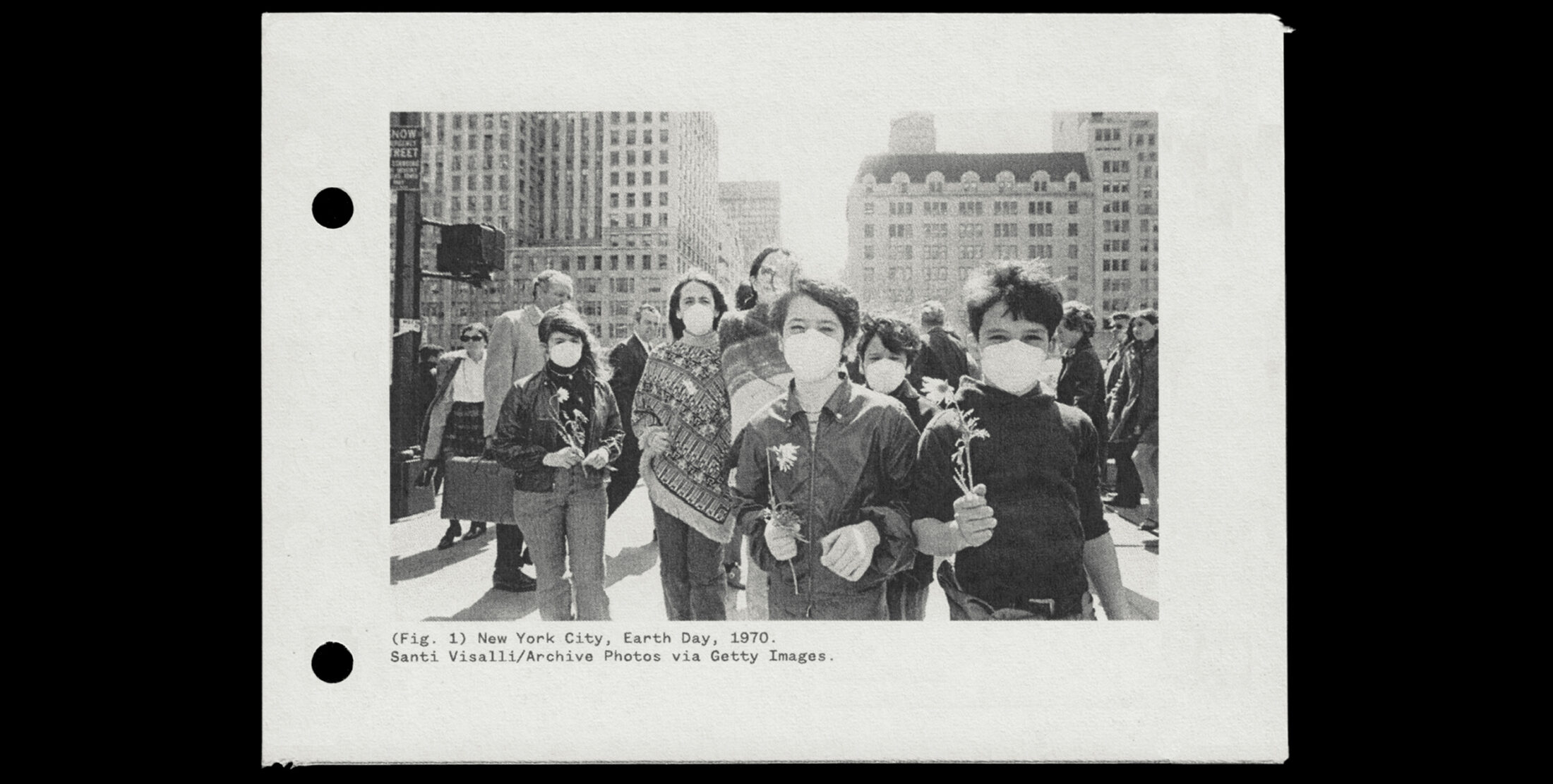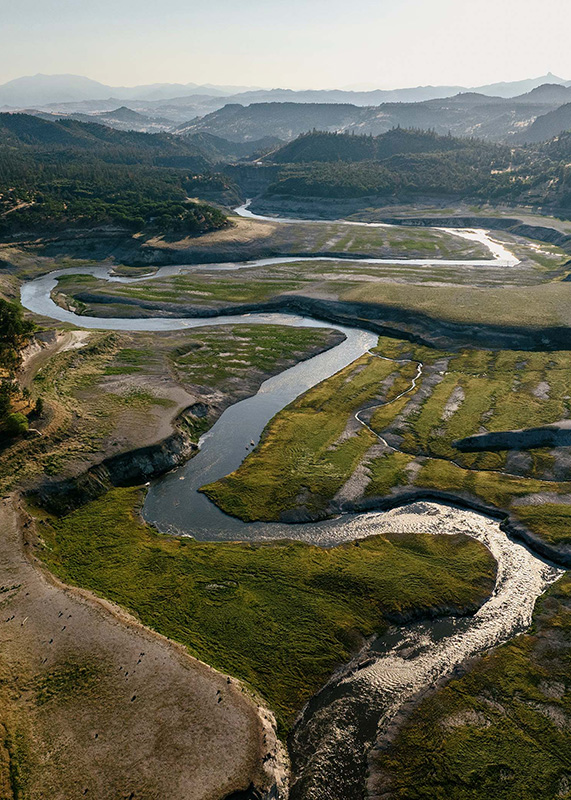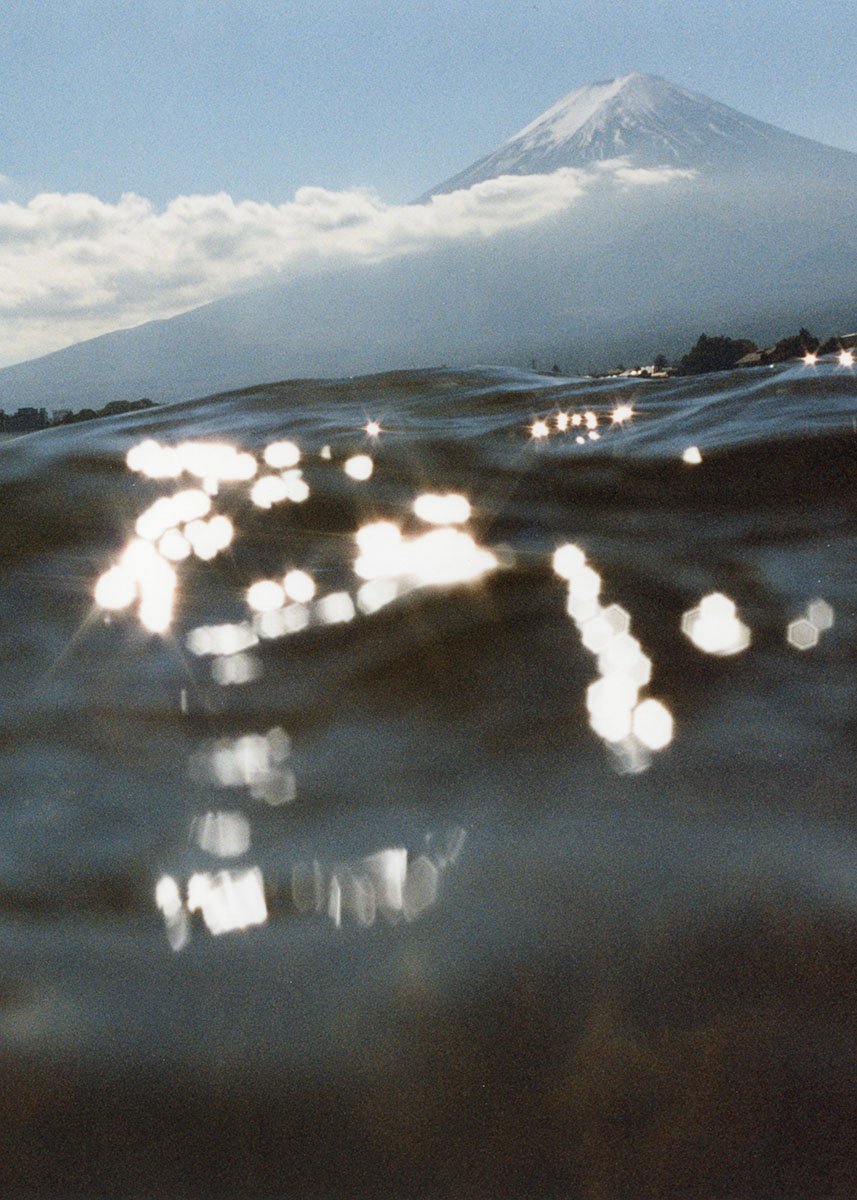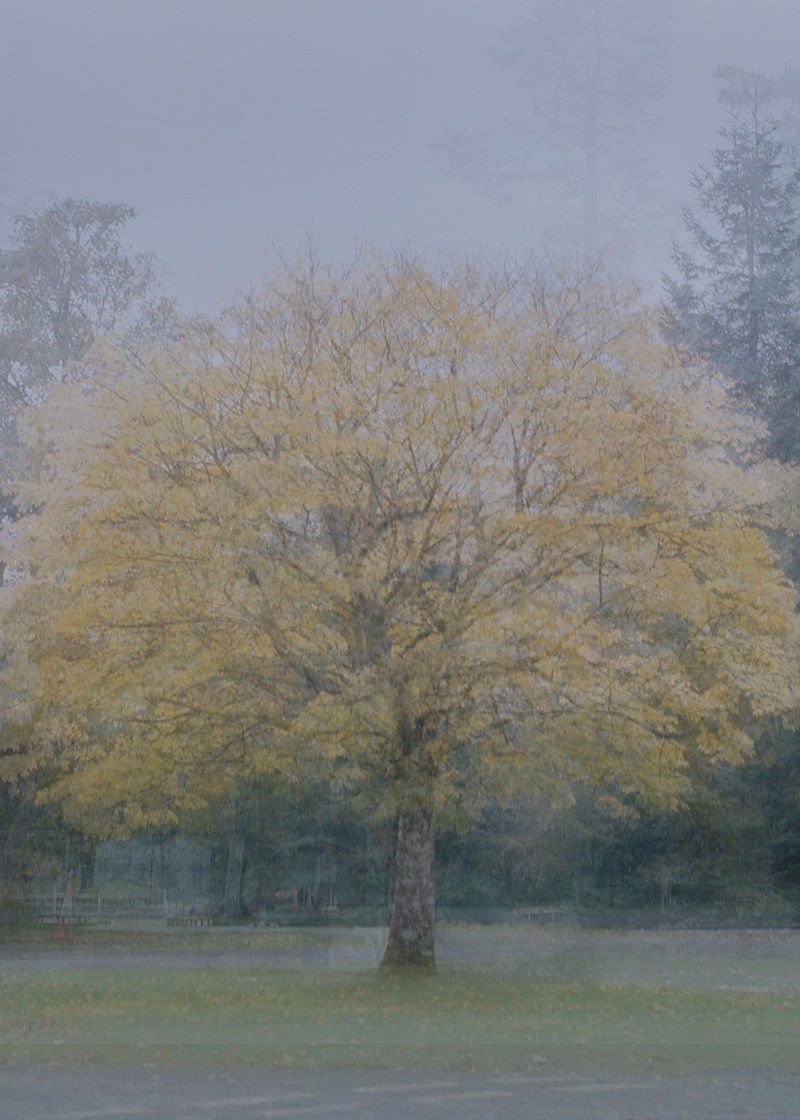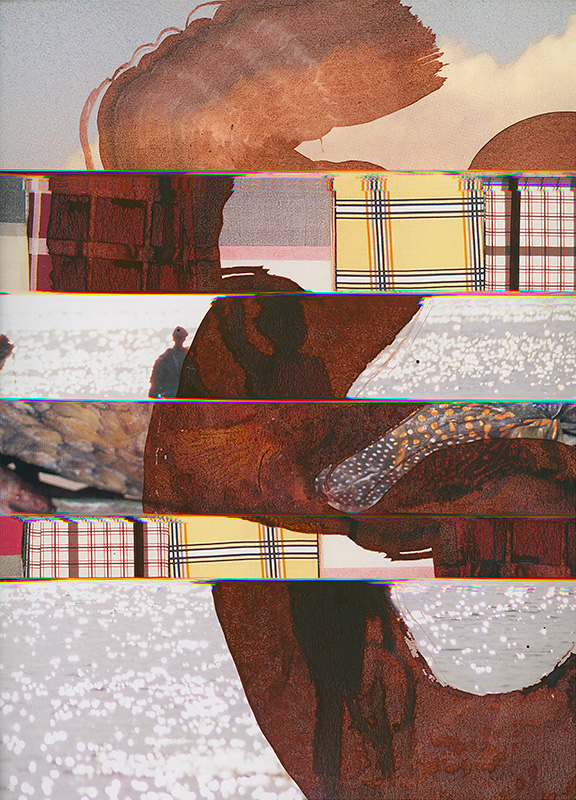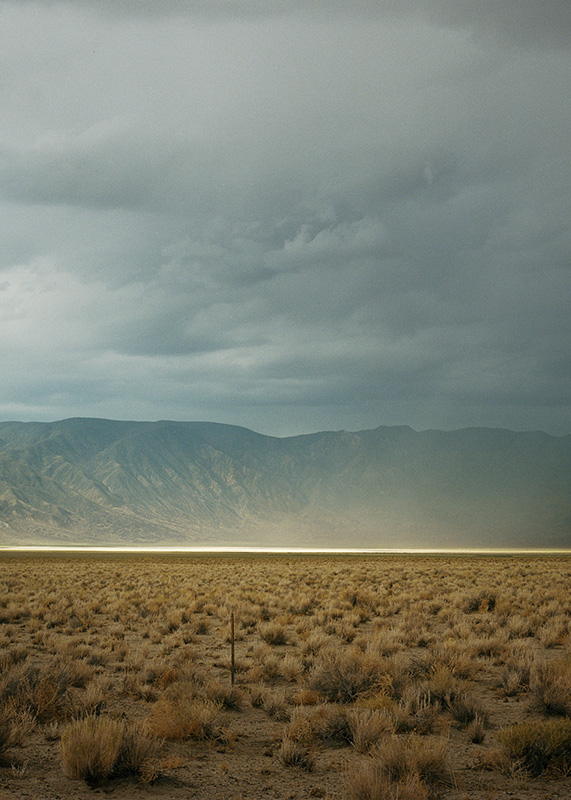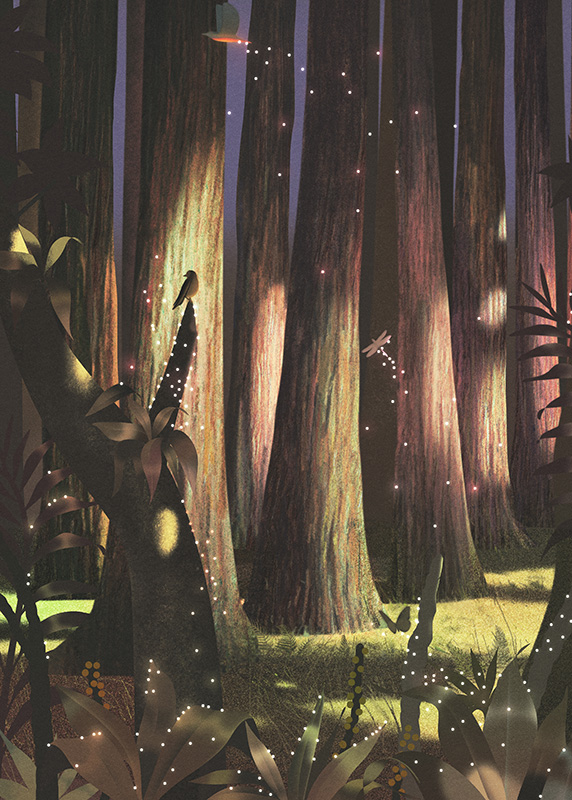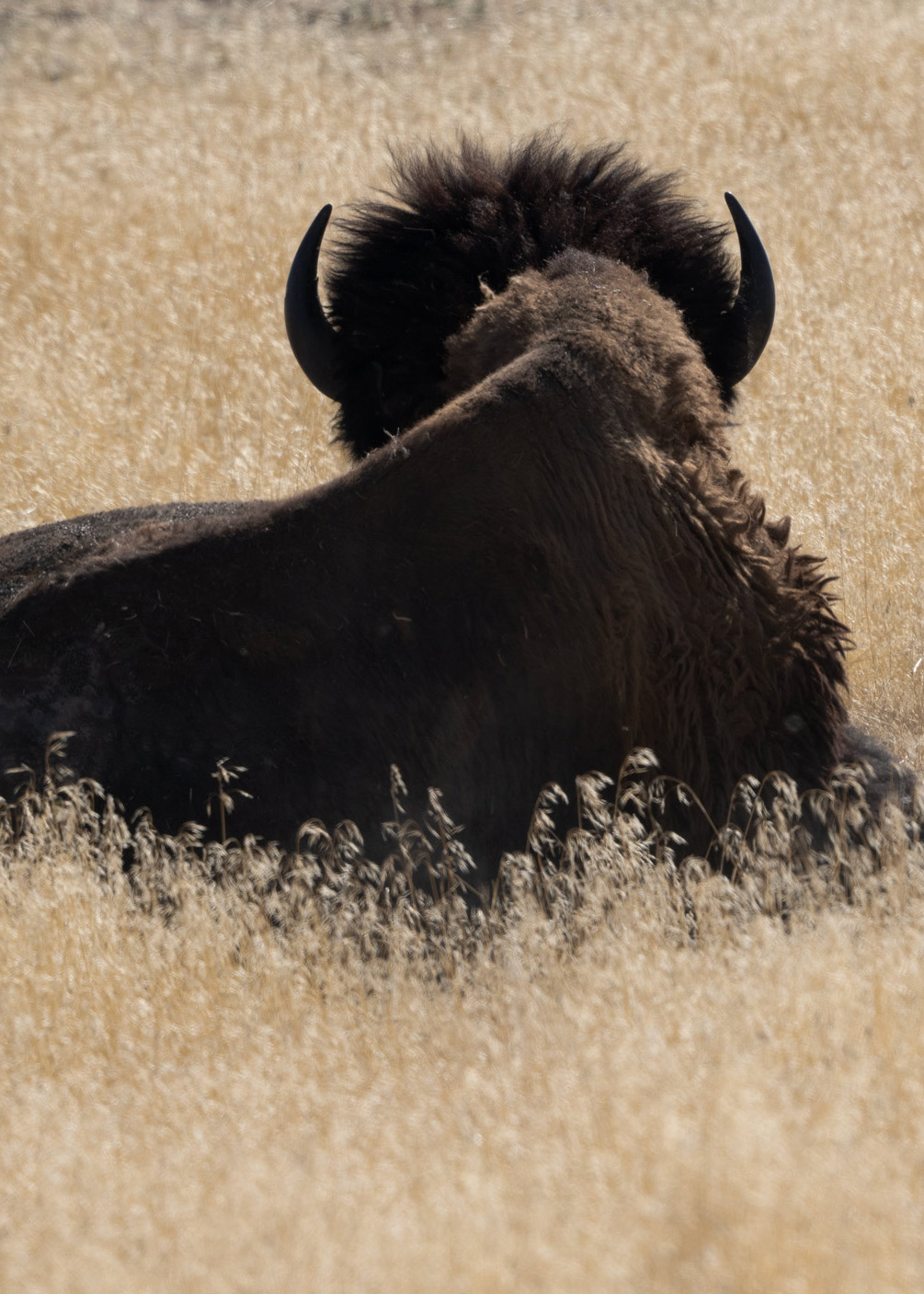
Paul Elie is a senior fellow in Georgetown University’s Berkley Center for Religion, Peace, and World Affairs and a regular contributor to The New Yorker. He is the author of two books, The Life You Save May Be Your Own and Reinventing Bach.
This year marks the fiftieth anniversary of Earth Day. For this monumental occasion, Paul Elie traces the literary history of the environmental movement from Rachel Carson’s Silent Spring to Pope Francis’s encyclical on the environment.
The June 16, 1962, issue of The New Yorker ran 132 pages and carried the cover price of a quarter. In it was a short piece on the pleasures of walking in Central Park; a poem by James Dickey; a piece about baseball by Roger Angell; stories by Peter DeVries and Shirley Hazzard; a review of John Ford’s picture The Man Who Shot Liberty Valance; and ads for Fleischmann’s vodka, Beefeater’s gin, Martini & Rossi vermouth, Taylor vermouth, Steuben Glass, B. Altman & Co., the Bank of New York, Chevrolet, DuPont Chemical, and the new novels by Isaac Bashevis Singer and William Faulkner. Running from page 35 to page 99 was a piece by “A Reporter at Large.” The topic was the adverse effects of pesticides on the air and water and on plant, animal, and avian life. The headline was “Silent Spring: I,” and the reporter, named at the end in small type, was Rachel Carson.
Silent Spring, published in book form later that year, is often said to have jump-started the environmental movement. Specifically, Carson’s report—circulated among members of the Kennedy Administration prior to publication—is said to have helped to bring about the outlawing of DDT (the most commonly used pesticide at the time, produced by DuPont, among other companies); the founding of the Environmental Defense Fund, which soon emerged as a durable and effective nonprofit group; and the creation, in 1970, of the Environmental Protection Agency, whose work one journalist later characterized as “the extended shadow of Silent Spring.”
The first Earth Day, eight years later—April 22, 1970—is likewise said to have jump-started the environmental movement. That day something like twenty million Americans (a tenth of the United States population at that time) took part in events or programs related to “nature” and “conservation” at colleges, universities, and schools. Earth Day was swiftly established as an annual event. Following the pattern of the very practices that environmentalists sought to combat, the event grew and spread—went “to scale,” as it is now said—to the point that it has become, according to the nonprofit earthday.org, “the largest secular observance in the world.”
This Earth Day was set to mark the modern environmental movement’s golden jubilee. The organizers envisioned a blend of public assembly, action, and celebration on a grand scale. “Earth Day 2020 will be far more than a day,” they declared on earthday.org, in a rhetorical mood that might be called the visionary imperative. “It must be a historic moment when citizens of the world rise up in a united call for the creativity, innovation, ambition, and bravery that we need to meet our climate crisis and seize the enormous opportunities of a zero-carbon future.”
Then the coronavirus spread, and earthday.org took Earth Day 2020 online.
What are words worth? What difference does a day make? The fiftieth Earth Day was unlikely to see such an uprising as the planners had in mind, even before the spread of the coronavirus forced people away from collective action. And yet it’s worth asking what effects the actions undertaken on Earth Day—in whatever form—are likely to have, and what the significance is of the day as an action in itself.
These questions point to the question that underlies both Earth Day and the circumstances that called it forth. It’s the all-encompassing question of the impact of particular human actions for the existence of the planet as a whole. This is the question that Carson put front and center to such powerful effect. “The history of life on earth,” she observed, “is a history of the interaction of living things and their surroundings. To an overwhelming extent, the physical form and the habits of the earth’s vegetation and its animal life have been molded and directed by the environment. Over the whole span of earthly time, the opposite effect, in which life modifies its surroundings, has been relatively slight. It is only within the moment of time represented by the twentieth century that one species—man—has acquired significant power to alter the nature of his world, and it is only within the past twenty-five years that this power has achieved such magnitude that it endangers the whole earth and its life.”
From Silent Spring onward, the environmental movement in the United States has sought to register the effects of human actions on our surroundings. And yet the effects of the movement’s own actions are hard to register precisely. Is it working? Is it making a difference? Locally, the answer is yes, yes, a thousand times yes. And yet the progressively unpropitious circumstances of the Earth and its atmosphere over the past half century suggest that the movement’s actions have had little aggregate effect. It suggests a disconnect between actions and effects, between the moment in time when a human action is undertaken and the deep time in which the effects on the Earth can be discerned in terms we in our time can understand.
What are words worth? What difference does a day make? Those are questions that the serious writer asks daily. We ask them because the serious writer must ask, in a personal way, what the effects of the act of writing might be on the people who encounter it as readers—a collective entity the writer cannot see clearly (since its makeup is changing constantly) but can only imagine. We ask them because, in so many ways, the act of writing—the screen, the desk, the shaping of horizontal lines of clustered, shaped, filamented black light—is commonly seen as an evasion of action. And we ask them because the serious writer works in deep time, where the relation between actions and effects is hard to discern. An author of a work of long-form nonfiction, say, 50,000 words, may spend a year of reporting and another year of writing in order to produce a text that can be read on a plane flight from New York to San Francisco and then discarded at the end of the jetway.
My own encounters with the environmental movement have come mainly through encounters with books and long-form nonfiction writing, much of it published in The New Yorker, as Silent Spring was. With those encounters in mind, I’d like to use the history of Earth Day as an informal time line to mark the unfolding of different approaches to the Earth and its atmosphere as seen both in the events of the day and in the writing about the Earth that emerged in the interstices—books and magazines stood up on end like markers on the time line.
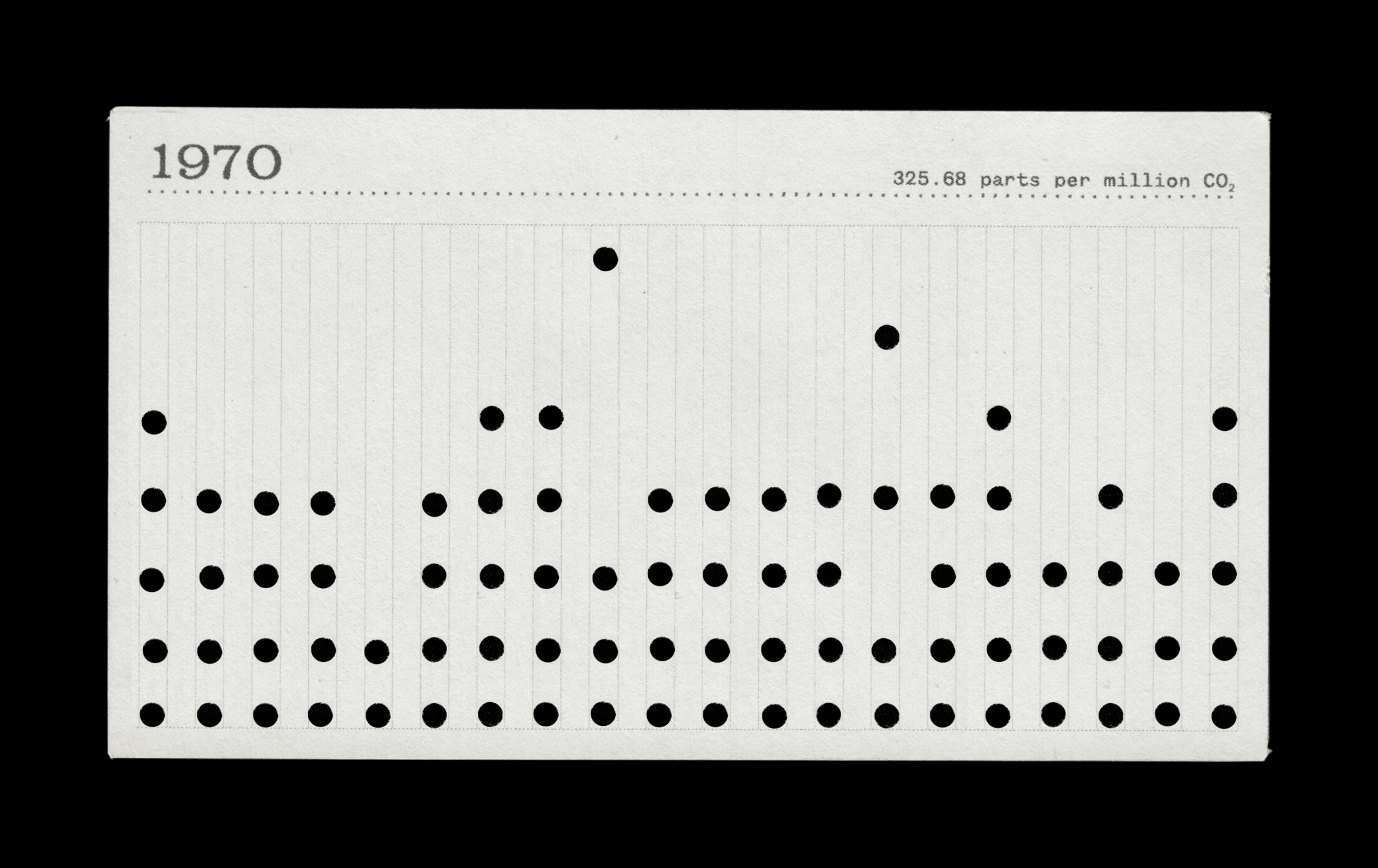
1970: Earth Day is established. Gaylord Nelson, Democratic senator from Wisconsin, is the instigator. After reading an article in Ramparts about student opposition to the US war in Vietnam, he envisions “a national teach-in on the environment.” Denis Hayes—recent Stanford graduate, student body president—is tapped as chief organizer. Hayes leaves Harvard Law School in order to put efforts in place. He settles on April 22 as an apt date, because it falls midway between spring break and final exams. To represent the event visually, the organizers use the photograph known as “Earthrise,” taken by Apollo astronauts in 1968, which prompted the poet Archibald MacLeish to observe: “To see the Earth as it truly is, small and blue and beautiful in that eternal silence where it floats, is to see ourselves as riders on the Earth together, brothers on that bright loveliness in the eternal cold.” On April 22—a Wednesday—the weather is fine throughout the country. In New York, Mayor John Lindsay closes Fifth Avenue to vehicular traffic, and Earth Day participants walk from 59th Street to Union Square. A gaggle of activists drag a net full of dead fish down the avenue, calling out to passersby: “This could be you!” In the days after, some feature writers announce the beginning of “the environmental decade”; others dismiss the movement as a fad. Denis Hayes says, “If the environment is a fad, it will be our last fad.”
John McPhee’s Encounters with the Archdruid was published in The New Yorker in three parts in the spring of 1971. McPhee has described the work’s structure as “ABC over D”: a triple profile of David Brower, ousted leader of the Sierra Club and founder of Friends of the Earth, told through “encounters” with three antagonists of conservation he met in his work—a mining engineer, a developer of golf courses, and an advocate for giant, canyon-filling, hydroelectric-power-producing dams, such as those that produce a combination of controlled freshwater and electricity, enabling the phenomenal postwar development of the American West. The climactic encounter is between Brower and the dam builder—Floyd Dominy, head of the US Bureau of Reclamation—dramatized in a running conversation as they travel down the Colorado River and through the Grand Canyon on a white-water rafting expedition, drinking canned beer and smoking cigars. The local conceit is clear and strong: they are moving through a landscape of profound history and spectacular beauty that will be flooded if Dominy and the forces of development have their way (as they’ve had their way already with Glen Canyon upstream). The larger conceit is clear, too: conservation is a series of battles, with dams and developments beaten back through aggressive, unyielding collective action. McPhee describes a battle over a proposed dam—the Echo Park Dam—in the Dinosaur National Monument, in Colorado. “The Dinosaur Battle is noted as the first time that all the scattered interests of modern conservation—sportsmen, ecologists, wilderness preservers, park advocates, and so forth—were drawn together in a common cause. Brower, more than anyone else, drew them together, fashioning the coalition, assembling witnesses.” Brower used facts, arguments, math, and “publicity—paid advertisements, a film, a book—envisioning a National Monument of great scenic, scientific, and cultural value being covered with water.” The opposition worked; the battle was won. Concluding, McPhee laconically observes, “There is no dam at the confluence of the Green and the Yampa. Had it not been for David Brower, a dam would be there.”
Reading McPhee’s profile a decade after publication was something like finding the greatest conservation story ever told. Ten and twenty years later, it had the same effect. This was journalism as literature: permanent, out of time. So it seemed; so I wished. To read it today (it is as strong as ever) is to read it in the future that its protagonist envisioned—the future for the sake of which those giant dams were resisted. McPhee ends the story of the Dinosaur Battle with a brief, pointed postlude: “There are no victories in conservation, however. Brower feels that he can win nothing. There is no dam at the Green and the Yampa now, but in 2020 there may be. ‘The Bureau of Reclamation engineers are like beavers,’ he says. ‘They can’t stand the sight of running water.’”
It’s a memorable formulation: the government as the erector of impediments, the activist as the defender of nature’s right to take its course. It worked well for David Brower. And yet it overspills its banks. The image of conservation that Brower deployed with great success is actually one of impediment and resistance: of the force of civilization, powerful but impermanent, holding back the force, akin to rushing water, that is construction and development—holding it back as a dam would do.

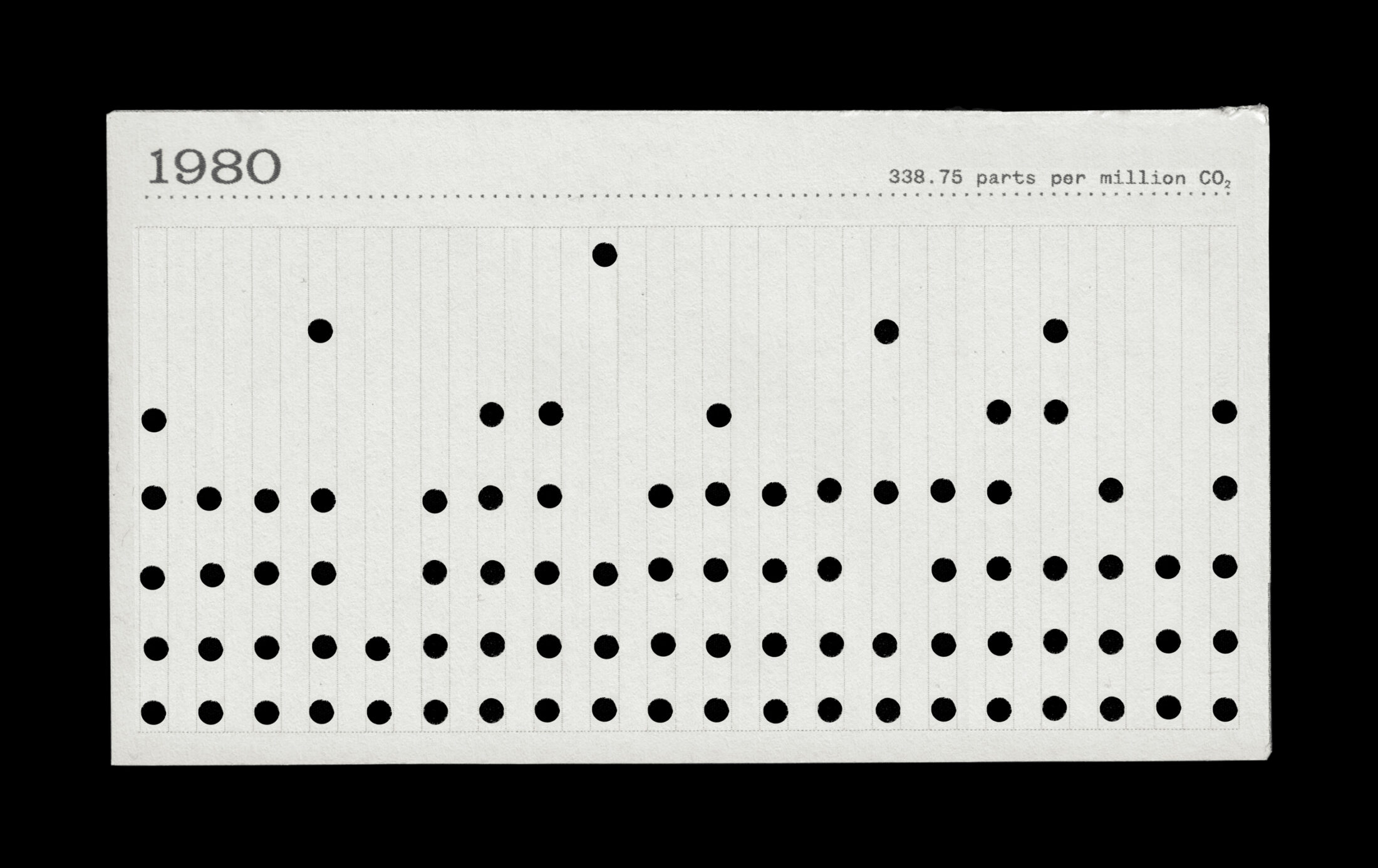
1980: The Earth Day poster shows a caged globe of longitudes and latitudes held up by hands, black and white—Earth sustained by humanity, so to speak. President Carter, declaring April 22 Earth Day [on January 1], announces: “We have now begun to make a serious investment in the quality of the environment at home and abroad. The earth is a fragile asset. The return on wise investments in our environment will be reaped not only by ourselves, but by generations of our descendants.” The clunky mixed metaphor—joining farming and finance—seems telling in retrospect. That November Carter loses his bid for re-election. So does Senator Gaylord Nelson, founder of Earth Day, defeated by Bob Kasten, a Republican. Nelson goes to work as a counselor for the Wilderness Society—for the environmental lobby, his opponents would say. When Kasten later loses his seat, he will go on to work for Republican presidential candidate Rudy Giuliani and endorse John McCain. In time, he will serve in the Trump Administration.
In April 1980 Dave Foreman co-founded Earth First!, a radical environmental group frankly conceived as an alternative to the “common cause” approach. In the years that followed—as newly elected President Ronald Reagan appointed extraction-industry lobbyist James Watt as interior secretary, thus declaring war on the federal environmental regulations enacted in the previous decade—the Earth First!ers sought to be an “aggressively prankster organization.” L.A. Kauffman, in Direct Action, explains: “Many of the group’s actions were delightfully impish: forcing the closure of a Colorado golf course by inscribing ecological graffiti in the greens; burying salt under a dirt airstrip in Idaho so that moose and deer would rip up the runway; putting cow pies over the intake vents of a Forest Service supervisor’s office air conditioner.” In Colorado, which had been the setting of David Brower’s exploits, they devised a giant plastic “crack” and affixed it to Glen Canyon Dam (the dam upriver from the Grand Canyon) as a way to suggest the vulnerability of the structure: what goes up, will come down.
Over time EarthFirst! would become at once more aggressive and more ingenious. They would blockade forests. They would drive spikes into trees tagged for removal, so as to mar and distend the giant saw blades the loggers used to cut the trees down. They would chain themselves to logging trucks. They would chain themselves to giant redwoods. What effects did the movement aim to bring about through these actions? Foreman, early on, explained: “Maybe a species will be saved or a forest will go uncut or a dam will be torn down. Maybe not. A monkey wrench thrown into the gears of the machine may not stop it. But it might delay it. Make it cost more. And it feels good to put it there.”
Foreman’s account carried an oblique reference to his source of inspiration. Earth First! came out of The Monkey Wrench Gang, by Edward Abbey, published in 1975. Abbey, an Easterner, spent summers at Arches National Monument, which inspired his book Desert Solitaire, a work of environmental agitprop rooted in his spirited revulsion for the crowding of the West through the national parks and concluding with a heartbreaking account of his exploration of the since-flooded Glen Canyon.
The Monkey Wrench Gang is something else: at once a comic novel, an imaginative manifesto, and a how-to manual. The Gang devote themselves to disrupting the development of the still largely unsettled West: bridges, roads, coal-mining operations. They begin by climbing into an idle bulldozer, loosening the gas cap, sloshing a gallon of corn syrup in with the diesel fuel, and then take it from there. Their opponent isn’t the government or a particular company. It is the whole extracto-industrial complex that has established itself beyond a seeming point of no return. The gang brainstorm their approach in a colloquy outside a coal chute:
“It ain’t people,” said Smith. “It’s a mechanical animal.”
“Now you’ve got it,” Doc agreed. “We’re not dealing with human beings. We’re up against the megamachine. A megalomaniacal megamachine.”
“No sweat,” Hayduke said. “It’s all rigged up for us. We’ll use that fucking conveyor to blow up the loading towers. Nothing could be prettier. Look—it’s so goddamned simple it makes me nervous. We take our shit out in the woods there, close to the belt. We throw it on the belt, light the fuse, cover it up with a little coal, let it ride up over the road and into the tower. Ka-blam!”
“How do you time it?”
“That’s the mathematical part. We have to figure out the speed of this thing, measure our distance from the towers, calculate how much fuse we need. Simple.”
“Suppose,” said Doc, “there’s someone working up in those loading towers?”
“That’s just a chance we’ll fucking well have to take,” Hayduke said.
The story of Earth First!’s origins has acquired the authority of a creation narrative, and an empowering one. Here is a vivid expression of the breach between political action and direct action, between progressives and radicals, and a winning argument for the latter. Here is a real-world movement inspired by a work of fiction—strong evidence of the power of literary writing to have effects in the world of direct action and, by extension, effects on the planet itself.
Empowering—but it’s not that simple. For one thing, Abbey, in writing The Monkey Wrench Gang, drew on actions undertaken by actual activists: the “billboard bandits,” who felled ads along Michigan’s highways; the greatly agitated wag who plugged up a factory smokestack so as to curb toxic emissions firsthand. For another, these expressions of direct action—“ecotage”—were celebrated and sponsored by Environmental Action, founded on the first Earth Day. The radicals had been aided and abetted by the moderates. Environmental Action “even held a contest for the best sabotage tips,” Kauffman explains, “compiling the most intriguing entries in a paperback guide published by Simon & Schuster.”
At the other end of the eighties—September 11, 1989—The New Yorker published a long article about the environment, under the headline “The End of Nature.” The author, William McKibben, had worked at the magazine’s offices in Manhattan practically since college, writing several hundred features and “casuals” on a multitude of subjects; at the same time, he had grown progressively more interested in the environment, eventually moving from Broadway and Bleecker Streets to a home in Adirondack Park in upstate New York. In the New Yorker article—published as a book soon afterward—McKibben developed the idea that “nature” as commonly understood had come to an end, so thoroughly had the natural world been pervaded by human activity. In his account, the relatively recent geological and atmospheric shift Rachel Carson had described—from life shaped by the environment to the environment shaped by life—was a permanent existential condition. In that sense, The End of Nature was a beginning. It introduced a broad public to the discussions, far advanced among scholars and activists, about the limits of referring to “nature” as a phenomenon in itself and the need—both philosophical and practical—to frame issues involving ecology, conservation, land use, resources, and the like in terms of planetary interdependence.
This book about an end was a beginning in another sense, too. Partway through, in the middle of a paragraph, without any feature-writer’s billboarding or other annunciatory gesture, there was this passage: “A model devised by the World Resources Institute predicts that if energy use and other contributions to carbon-dioxide levels continue to grow very quickly, the amount of atmospheric carbon dioxide will have doubled from its pre-Industrial Revolution level by about 2040; if they grow somewhat more slowly, as most estimates have it, the amount will double by about 2070. And unfortunately, the solutions are neither obvious nor easy.” In the next column, there was this: “Burning fossil fuels is not the only method human beings have devised to increase the level of atmospheric carbon dioxide. Burning down a forest also sends clouds of carbon dioxide into the air. Trees and shrubby forests still cover 40 percent of the land on Earth, but the forests have shrunk by about a fifth since pre-agricultural times, and the shrinkage is accelerating.”
The End of Nature, received as a progressive jeremiad, seems understated today. But Bill McKibben was alarmed. He kept writing on diverse subjects: cross-country skiing, population, genetic engineering. He also doubled down as an activist. With those two passages in The New Yorker, he had set out the central developments of what is now called the climate emergency, and it can be said that his career since then has been one of sustained personal action in response to the effects he described there. Those two passages have informed interviews, articles, lectures, speeches, and rallies beyond numbering. They are the basis for two organizations he founded: Step It Up and 350.org. The latter is now present in over 188 countries. Its signature event, the People’s Climate March, drew large groups of people into the streets in 2014 and 2017, and in 2019 its draw was sufficiently powerful to persuade New York City to allow public-school students to take part in lieu of going to school. The People’s Climate Movement owes much to Earth Day; at the same time, it seems a corrective to Earth Day in its unstinting focus on a small number of goals, lately presented as a Green New Deal “to deeply reduce carbon emissions, create millions of good union jobs, and strengthen those communities facing the worst effects of the climate crisis.”
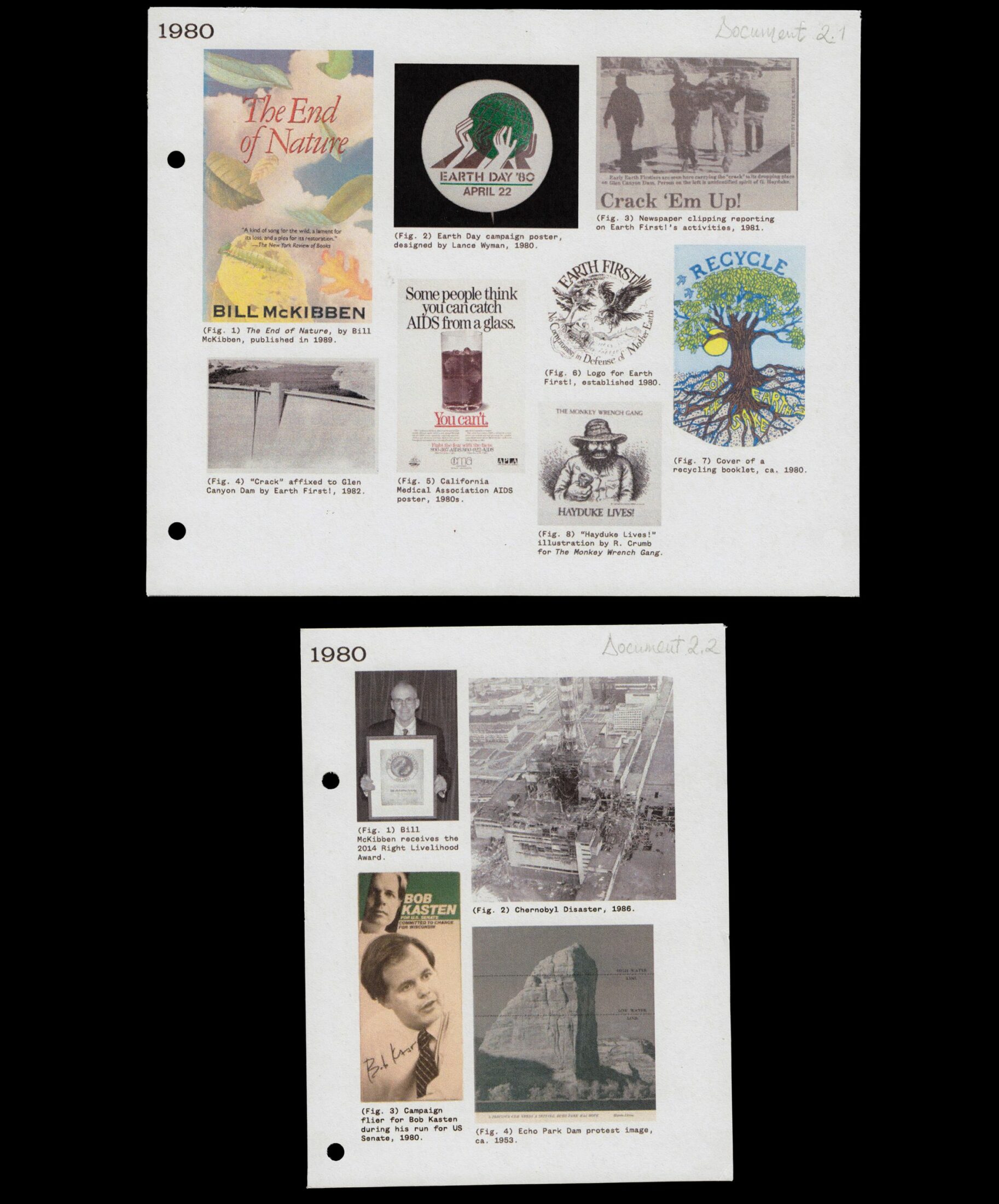
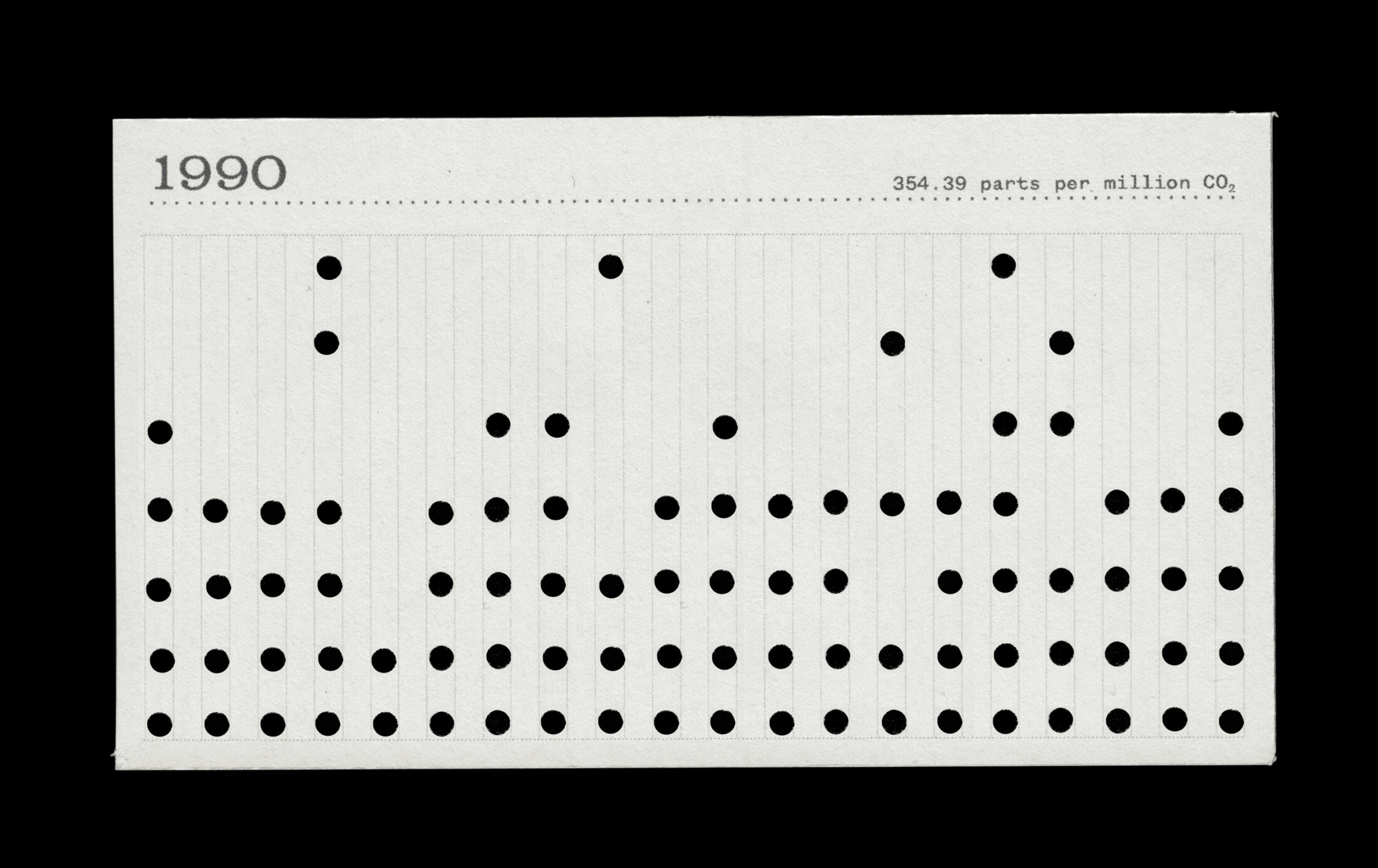
1990: The twentieth anniversary of Earth Day is marked with events in over 140 countries: rallies, protests, teach-ins, and the like. Two hundred million people take part. (In a poll the previous year, 76 percent of Americans polled describe themselves as “environmentalists.”) Three hundred fifty thousand people assemble on the Mall in Washington, DC, to hear the Indigo Girls, 10,000 Maniacs, Michael Stipe, Billy Bragg, et al.; in New York City, seven hundred fifty thousand people gather on the Great Lawn to hear Hall & Oates, the B-52’s, Edie Brickell & New Bohemians, and Ric Ocasek from the Cars. Cesar Chavez—leader of the United Farm Workers—is there; so is Barry Commoner, first proponent of the idea of “sustainability.” A chant ripples through the crowd—“Hello, people! Hello, trees!”—and then falters.
Twenty years on, the “Earth” part of Earth Day had taken hold. Among all but climate-change denialists (no small minority, alas), there was a general understanding that the movement was not principally about conservation of wild places, and that the object of concern was not the environment per se; rather, the issues of pollution, development, resource use, and the like impacted the planet as a whole and the well-being of all the living things on it, present and future.
The strongest and clearest voice of this emerging view, in the United States at least, was Al Gore. Gore (he recalled) had noticed his mother reading Silent Spring in their home in Tennessee when he was a teenager. He had given attention to environmental concerns all through his career in politics: as congressman, senator, and presidential candidate. After he bowed out of the 1988 campaign, he wrote a complex book on the topic, called Earth in the Balance. It was published in 1992, shortly before he joined the Democratic ticket as Bill Clinton’s running mate; and after Clinton’s victory, the vice presidency became, for a time, Gore’s bully pulpit for concerned international climate action.
The nut graph of Earth in the Balance brought together themes from several phases of the environmental movement—a term that was passing out of use. “The world is once again at a critical juncture,” Gore declared. “We are invading ourselves and attacking the ecological system of which we are a part. As a result, we now face the prospect of a kind of global civil war between those who refuse to consider the consequences of civilization’s relentless advance and those who refuse to be silent partners in the destruction.… [T]he time has come to make this struggle the central organizing principle of world civilization.” Through Gore, the notions of the interdependence of the planet and the atmosphere, and the interdependence of humans and the planet, were put forth boldly for a huge international public.
In publishing terms, Earth in the Balance was a remarkable success. It sold millions of copies. It became the summation of and point-of-sale takeaway for Gore’s “climate talk,” which he delivered to audiences of all sizes more than a thousand times. Updated, it served as the basis for the 2006 documentary film An Inconvenient Truth—the climate talk framed for the big screen, with spectacularly alarming graphics and footage evidencing climate change. And yet the success of Earth in the Balance was sharply qualified. The concerted climate action Gore called for in the book was given political expression in the Kyoto Protocol—a United Nations treaty, drawn up during the Clinton Administration, that committed the nations of the world to sustained, monitored reduction of greenhouse gas emissions. The Kyoto Protocol was enacted in 1997, with 192 countries as signatories. The United States was not one of them. The Clinton Administration, even with Al Gore as vice president—Gore, the longtime senator and son of a senator; Gore, the Harvard-educated, strong-jawed, thick-haired boy wonder; Gore, the author of a bestselling book on climate action and tireless giver of the “climate talk”—could not bring Congress to ratify the treaty. Three years later, Gore had another chance, mounting a presidential campaign which, by all indications, was poised to keep the White House in Democratic hands. He lost, ceding the state of Florida after a tally produced under suspicious circumstances favored his opponent, George W. Bush, by a few hundred votes. Should Gore have spent less energy as an author persuading the public and more as a politician persuading his Senate colleagues? In retrospect, it seems so. The United States is still not a signatory to the Kyoto Protocol.
In India during those years, Arundhati Roy was moving in the opposite direction, shifting from authorship to activism, using the worldwide cultural power she had gained through literature to effect change in one country’s policies toward the environment. Roy’s first novel, The God of Small Things, published in 1997, won the Booker Prize in England and sold several million copies around the world. Roy herself became the face of postcolonial Indian writing and was named one of the “50 Most Beautiful People in the World” by People. Trained as an architect, she suddenly had as much cultural influence as any Indian in the West. Naturally, she sought to exercise it through her writing. She didn’t begin another novel, however. Instead, she wrote a long essay about the perils of India’s nuclear weapons program. Then she wrote a long essay on the topic that would consume her for the next decade or more: the development of giant dam projects in India’s Narmada Valley and their deleterious effects on people, culture, land, and water. “Instinct led me to set aside Joyce and Nabokov, to postpone reading Don DeLillo’s big book and substitute it for reports on drainage and irrigation, with journals and books and documentary films about dams and why they’re built and what they do,” she explained, as if the decision required a defense. She rejected the notion that undertaking such work—swapping fiction for nonfiction, lush works of the imagination for grim and gritty politics—represented a squandering of cultural capital: “I was drawn to the valley because I sensed that the fight for the Narmada had entered a newer, sadder phase. I went because writers are drawn to stories the way vultures are drawn to kills. My motive was not compassion. It was sheer greed. I was right. I found a story there.”
And what was the story? It was a story of Earth that upended the conventions of the Earth movement as it had developed in the West. The Narmada Valley Project committed the government of India, backed by international aid organizations, to build a network of 3,200 dams—“small,” medium-size, large, and mega—in the Narmada River and its tributaries. The dams, and the vast reservoirs created behind them, would displace some fifty million people (Roy’s cautious estimate) and would ruin or simply flood sites of human civilization built up over millennia. Yes, the dam project represented a spoliation of the natural world in the name of progress and development—progress and development that, once in place, would itself have harmful effects on soil, water, and climate. But for Roy, the dam project principally represented a spoliation of the human environment: of all those villages, at one end, and of the post-1947 project of Indian democracy at the other. At a moment when climate activists in the West were promoting models of global planetary interdependence—seeing Earth and its inhabitants as a single vulnerable organism—Roy focused without apology on unfettered development’s local and national human consequences.
“From being a fight over the fate of a river valley it began to raise doubts about an entire political system,” she wrote. “What is at issue now is the very nature of our democracy. Who owns this land? Who owns its rivers? Its forests? Its fish? These are huge questions. They are being taken hugely seriously by the state. They are being answered in one voice by every institution at its command—the army, the police, the bureaucracy, the courts. And not just answered, but answered unambiguously, in bitter, brutal ways.” Against that voice, Roy set her own; and then she did it again, and again. The book of her essays, My Seditious Heart—published by a small press, Haymarket Books—runs a thousand pages.

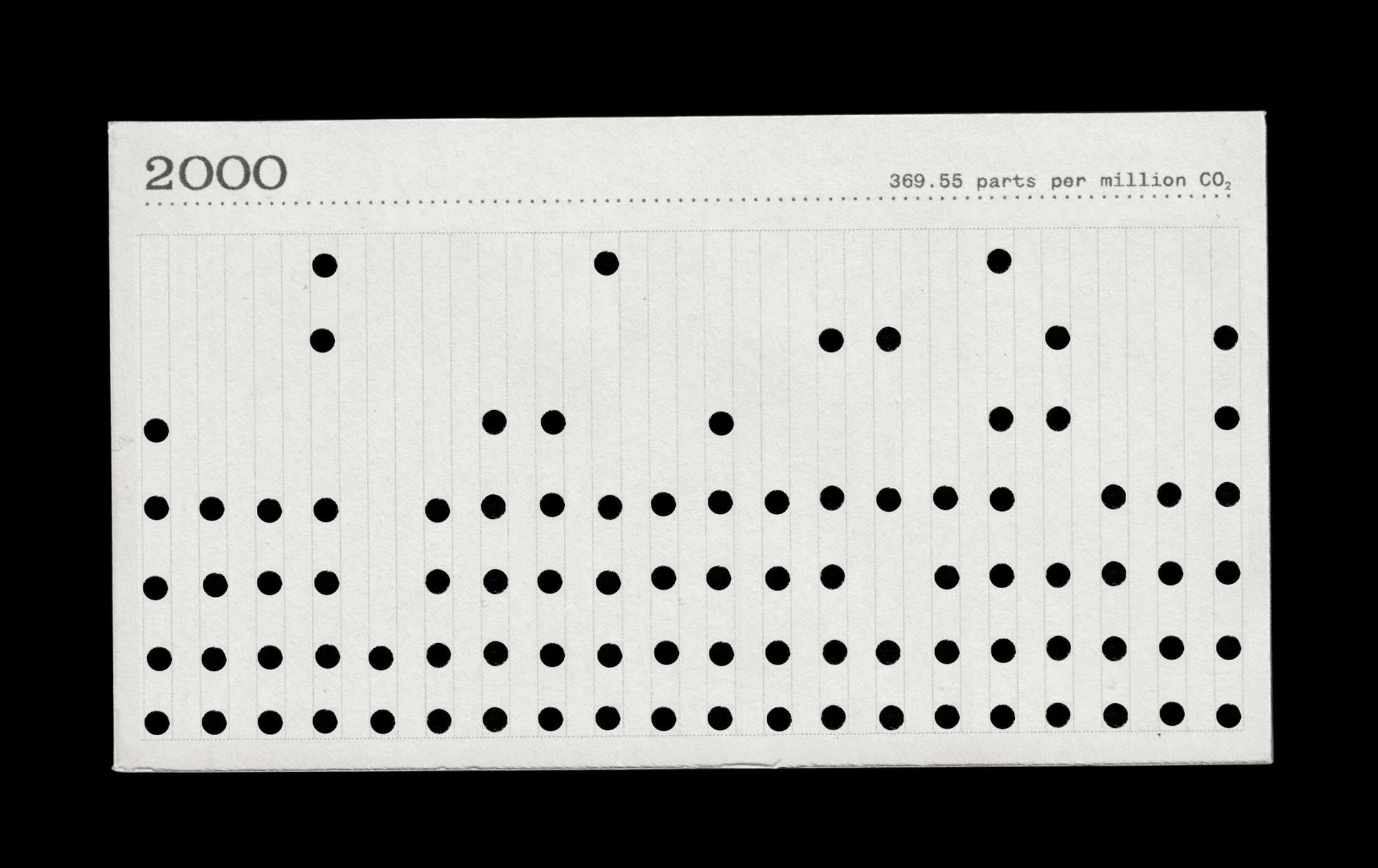
2000: Earth Day is marked in 184 countries. The theme is “global warming and clean energy,” and that’s a good thing: a survey conducted by Starch Roper International finds that “only 45 percent of Americans know that the burning of fossil fuels for transportation and electricity generation is the main cause of global climate change.” It’s a disquieting figure. It suggests that thirty years of Earth Days have scarcely affected public awareness.
“The Climate of Man” is the title The New Yorker gave to a three-part series by Elizabeth Kolbert, published in 2005. The title, clunky now, was an effort to make the vital point that global warming is the effect of human action. Kolbert reported on the study produced by a conference in Iceland, which she had attended with oceanographer Robert Corell. “The study’s executive summary stated, unequivocally, that human beings had become the ‘dominant factor’ influencing the climate. During an afternoon coffee break, I caught up with Corell. ‘Let’s say that there’s three hundred people in this room,’ he told me. ‘I don’t think you’ll find five who would say that global warming is just a natural process.’”
In Iceland evidence of climate change was at hand outside the conference center. “In the same way that global warming has gradually ceased to be merely a theory,” Kolbert observed, “so, too, its impacts are no longer just hypothetical.” The environmental reporter’s work, which for decades had made use of doomsday scenarios, statistical projections, and comparisons of the present age with previous ages of planetary time, now consisted of showing up, finding a guide, looking hard, and taking notes—notes, in Kolbert’s case, for the book she called Field Notes from a Catastrophe. “Sólheimajökull—the name means ‘sun-home glacier’ and refers to a nearby farm—is now eleven hundred feet shorter than it was just a decade ago,” Kolbert remarked. “Sigurdsson pulled out another notebook, which was filled with slides. He picked out some recent ones of Sólheimajökull. The glacier ended in a wide river. An enormous rock, which Sólheimajökull had deposited when it began its retreat, stuck out from the water, like the hull of an abandoned ship.
“‘You can tell by this glacier what the climate is doing,’ Sigurdsson said. ‘It is more sensitive than the most sensitive meteorological measurement.’”
You didn’t need to go to Iceland to see the evidence. For Americans it was close to home. “Nearly every major glacier in the world is shrinking; those in Glacier National Park are retreating so quickly it has been estimated that they will vanish entirely by 2030.”
2005: Earth Day is now the “Earth Day Network,” enabled and empowered by the World Wide Web. The Earth Day Network disseminates suggestions for DIY Earth Day efforts. “Go to a festival.” “Install solar panels.” “Change a habit.” The State of Hawaii (Slate reports) proclaims April 22 “Starbucks Earth Day, in honor of the giant coffee company’s eco-initiatives in the state.” Starbucks provides funding to the Earth Day Network—and to several dozen other environmental organizations—and prints Earth Day–themed messages on its paper cup sleeves, messages that “encourage environmental protection and suggest simple choices we can make to create a more sustainable world.” Starbucks Corporation publishes a 76-page report on its efforts in fair trade, conservation, sustainability, carbon impact, and the environment generally, including “Instilling Environmental Responsibility as a Corporate Value.”
“I think of that fork in the road and the subsequent great divide as the Thoreau problem,” Rebecca Solnit declared in 2007, in the essayist persona she had made distinctly her own: emphatically, distinctly, even idiosyncratically personal, and yet insistent that many of the distinctions that for so long formed the outlines of the person are social constructs that ought to be broken down, for they divide us (falsely) from one another. In “The Thoreau Problem” (published in Orion and then in Solnit’s book Storming the Gates of Paradise: Landscapes for Politics), the divide she has in mind is the divide between self and world, between so-called nature and human society. She finds that divide enshrined in the interpretation of Thoreau, namely, of the episode (recounted both in Walden and “Civil Disobedience”) in which Thoreau, released from jail after serving a brief sentence for protesting against the Mexican-American War, goes huckleberry-picking on Fair Haven Hill near Walden Pond. In Solnit’s reading, several generations of Thoreau’s admirers have used the episode to distinguish the two strains of Thoreau’s writing: his writing about nature, and his writing about politics. For Solnit this distinction is false, and worse: it is an expression of “the interpretive apartheid that divided up his territory.” It misses the point about Thoreau, who moved easily and freely from town to woods, from jail to huckleberry patch—in his life and in his writing. And it misreads the relation of landscapes and politics more broadly. It enshrines the view of the natural world—landscapes—as distinct from political concerns, even as a refuge from them. “This compartmentalizing of Thoreau is a small portion of a larger partition in American thought, another fence built in the belief that places in the imagination can also be contained,” Solnit declares. “Those who deny that nature and culture, landscape and politics, the city and the country are inextricably interfused have undermined that route for all of us, Thoreau’s short direct route so few have been able to find since.” Of course she is right. And yet it is telling that the image she chooses is that of a “fork in the road”—telling because a road is the most common way in which humans heedlessly transform the natural world so as to use it for our own purposes. Half a century after John McPhee took a rubber raft down the Colorado River with David Brower and Floyd Dominy, the notion of the Earth has come full circle. Now people who write about the Earth, inadvertently echoing the dam-builders and developers of previous eras, insist that the idea of “nature” as a distinct entity is a false construct, a lingering sentimentalism—unsustainable and so not worthy of protection.
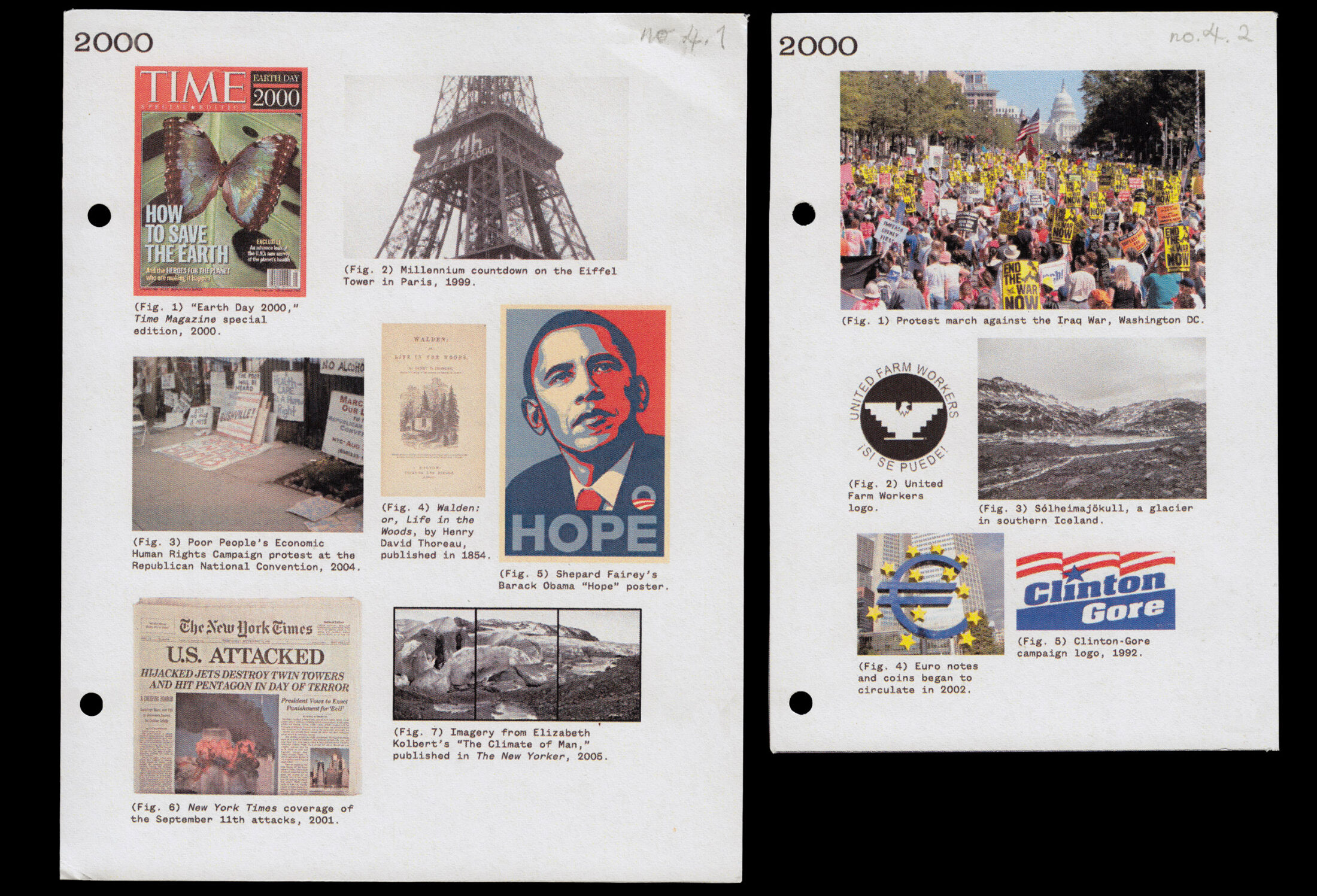
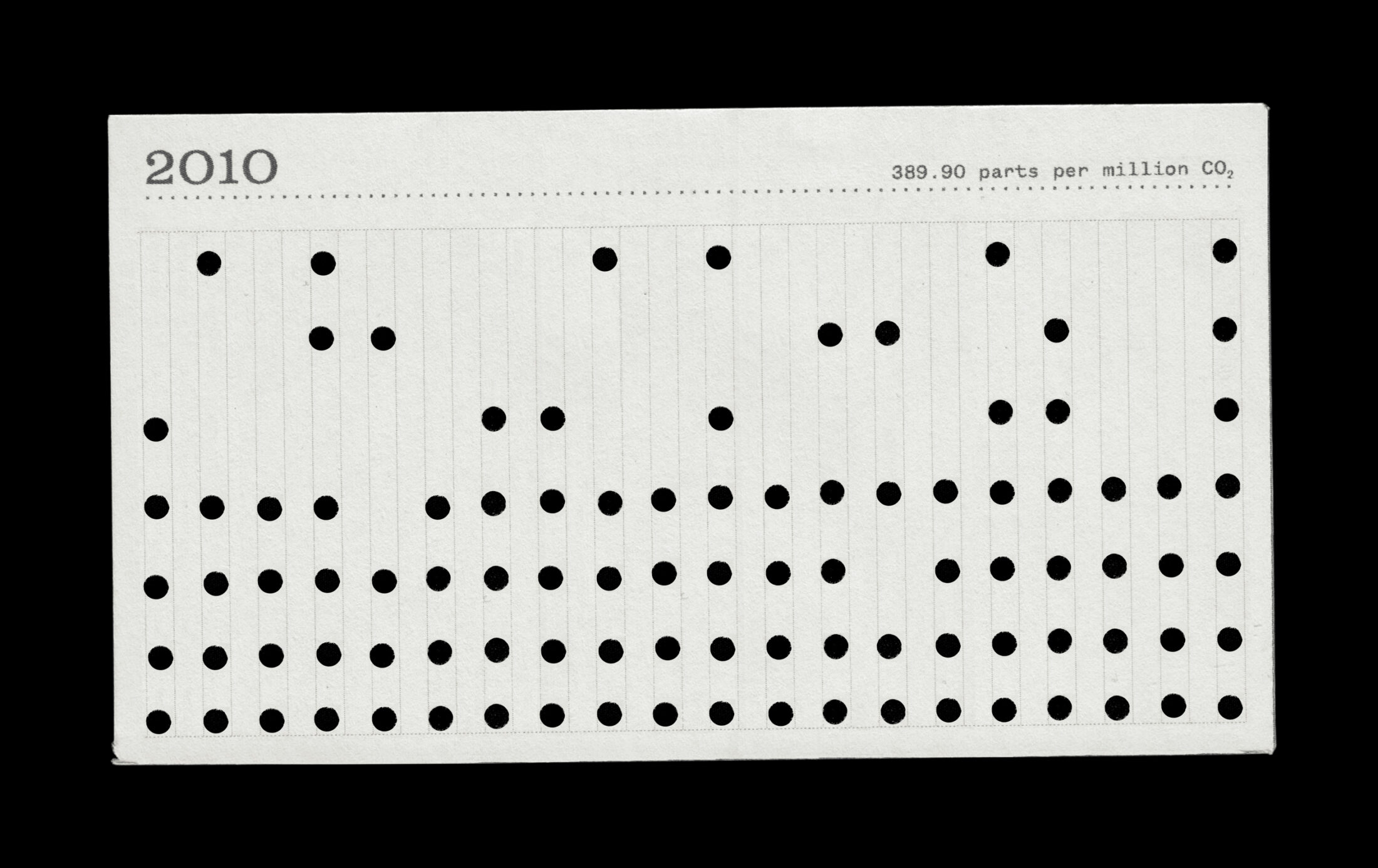
2010: More than a billion people are expected to take part in Earth Day–related events. (The actual number is past counting.) The adjective “related” captures the spirit of the day, forty years on. As a writer for The Nation remarks approvingly, “There’s something for everyone.” A walk over the Brooklyn Bridge “to raise awareness for clean water projects.” A Green Apple Festival at the Lincoln Park Zoo in Chicago. A carbon-neutral festival on the Santa Monica Pier in Los Angeles. Community gardens. Community clean-ups. Tutorials on how to build solar panels, solar cookers, solar hot water heaters. The usual concerts in Central Park and on the Washington Mall. A Google Doodle shows a tree canopy with birds frolicking beneath it. Robert Stone, director of a documentary called Earth Days, tells The New York Times: “The environmental movement in the late ’60s and early ’70s was driven by a strong sense of urgency that I think you see conveyed in the footage of those times. The movement now is sort of a victim of its own success in that our environment as a whole seems pretty good.”
Nature, or the environment, or the natural world? Earth, or the planet, or the global ecosystem? Conservation, prevention, or mitigation? A fate, an imminent catastrophe, or a climate emergency? All of the above—and then some? In a sense, it’s no wonder that the planet is in crisis in our moment, when for the past half century our understanding of both the planet and the crisis have been revised relentlessly, and for good reasons, by the very people whose role is to interpret the situation for the rest of us.
What’s a climate-minded concerned citizen to do? In 2015 two extreme positions, seemingly diametrically opposed, emerged as if side by side.
One is found in Pope Francis’s Laudato ‘Si: On Care for Our Common Home—an encyclical on climate change and inequality. The charismatic, boundary-breaking Jesuit pope decided shortly after his election in 2013 to commit his extraordinary religious and public influence—then at its apogee—to a sustained meditation on the climate emergency and the human role in it. On the surface, his characterization of the Earth as “our common home” is plainspoken, even homely. As developed in the encyclical, however, his notion of “care” for it is complex, multidimensional, as daunting as it is inspiring. For Francis urges his audience—Catholics, other Christians, and people of goodwill generally—to the life-altering process of “ecological conversion” away from our present “throwaway culture” and toward a holistic, biblically inflected, spiritually accented view of the planet and our place in it. This planet is God’s gift to us, to be regarded as such. It is a gift given to us all and equally. Accordingly, for Francis, care for our common home involves a good deal more than limiting resource use and carbon emissions. It involves reducing inequality among peoples, bringing about a more just distribution of goods and resources, adopting checks on property rights and the profit motive, swearing off consumptive excess, reining in the impulses toward immediate personal satisfaction, and setting aside an instrumentalist view of means and ends in favor of a mystical view of mutual interdependence. “Care for our common home” calls for a conversion, not just of our resource use, but of our whole way of life. Francis spells out the full breadth of what the call to “ecological conversion” means. “It … entails a loving awareness that we are not disconnected from the rest of creatures, but joined in a splendid universal communion. As believers, we do not look at the world from without but from within, conscious of the bonds with which the Father has linked us to all beings. By developing our individual, God-given capacities, an ecological conversion can inspire us to greater creativity and enthusiasm in resolving the world’s problems and in offering ourselves to God ‘as a living sacrifice, holy and acceptable.’”
It’s powerful, profound, and, for believers and those inclined toward belief, emboldening: but it seems to call for an “ecological conversion” as a precondition to worldly action, not as a process emerging from particular acts undertaken to ease the human influence on the planet and atmosphere. It’s as if each of us has to become a believer, and a believer of a certain kind, if human life on Earth is going to survive.
A few weeks before Laudato ‘Si was released, the great American novelist Jonathan Franzen made a diametrically opposed proposition about how to deal with the climate emergency in the pages of The New Yorker. At a time when climate fiction was just emerging as a category (the term “cli-fi” was featured in an NPR segment in 2013), Franzen had been incorporating environmental themes into his fiction for two decades. His overlooked second novel, Strong Motion (1992), is an environmental thriller of a kind, setting the Harvard seismologist-feminist Renee Seitchek against a Christian evangelist channeling the political energies of the religious right. Seitchek maintains that fossil fuel companies, chemical dumpers, and the extraction industry generally—the precursors of today’s frackers—approach the Earth with a sexual aggression, “literally raping nature” with their oil rigs and deep-drilling apparatuses, as Franzen put it. Freedom (2010) depicts a bird-loving fossil-fuel magnate who plans to strip-mine part of West Virginia and then turn it into an avian refuge for the rare cerulean warbler: an ingenious scheme to offset his crude exploitation of the natural world with the benevolent protection of it.
In The New Yorker, Franzen identified two approaches to planetary eco-activism. One blames humans for despoiling the earthly paradise and sees global warming as nature’s revenge. “And now climate change has given us an eschatology for reckoning with our guilt: coming soon, some hellishly overheated tomorrow, is Judgment Day. Unless we repent and mend our ways, we’ll all be sinners in the hands of an angry Earth.” The other takes its inspiration from St. Francis of Assisi, who sang to the birds, addressed Brother Sun and Sister Moon, composed a hymn to creation—Canticle of the Sun—and sought holiness through humble encounters with creatures, human and other, while tramping through medieval Umbria. A birder, Franzen found that his avocation awakened the Franciscan within him. “I became attracted to a countervailing strain of Christianity, inspired by St. Francis of Assisi’s example of loving what’s concrete and vulnerable and right in front of us. I gave my support to the focused work of the American Bird Conservancy and local Audubon societies. Even the most ominously degraded landscape could make me happy if it had birds in it.” And Franzen came to espouse (in his everyday life, and in the article) a “Franciscan” way of overcoming the spirit-numbing scale and abstraction of the climate emergency by working to preserve a particular aspect of the natural world—a bird species, a forest, a river system: “You’re helping something you love, something right in front of you, and you can see the results.”
Franzen’s article was taken as resigned, rejectionist—a famous novelist sticking it in the eye of all the good people who had worked so hard to render the astonishing breadth and multi-dimensionality of the climate problem. Characteristically, Franzen doubled down on it. In a New Yorker web piece in 2019, he bluntly urged people to recognize that the climate emergency isn’t coming, threatening, or imminent. It’s here. It’s upon us. And its effects are already manifest in realms that seem to have nothing to do with earth, air, or water. It’s manifest in the breakdown of social order, which is bound up with sudden changes in climate, the availability of natural resources, and the like. With that breakdown in mind, the climactically concerned citizen needn’t restrict herself to eco-activism, whether global or local. “In times of increasing chaos, people seek protection in tribalism and armed force, rather than in the rule of law, and our best defense against this kind of dystopia is to maintain functioning democracies, functioning legal systems, functioning communities. In this respect, any movement toward a more just and civil society can now be considered a meaningful climate action.” Here the environmental movement is turned back on itself, contrariwise. The solutions to our climate problems are the same good-government, enlightened-populace solutions to civic problems that were the obligation of the concerned citizen (the kind who kept up on current events through long-form journalism) before climate change came into view.
In 2018 there emerged a fresh figure in the climate emergency, one whom Franzen (fluent in German, chronicler of Scandinavians in America, drawn to brilliant, intrepid female protagonists) could have invented. This was Greta Thunberg the young Swede whose protests on behalf of climate action outside the Swedish Parliament in Stockholm brought her worldwide fame and swiftly made her the strongest voice in the climate emergency, the world’s single best-known young person, and a formidable antagonist of the petro-friendly, climate-change-denying US president, Donald Trump. Both her supporters and her critics pointed out that although Thunberg had mastered the intricacies of climate science, she said nothing distinctly new—nothing that environmental activists hadn’t been saying for half a century. And that was her point. There is nothing new to say. There aren’t a limitless number of new ways to say it. And if saying it in all sorts of ways for fifty years has made so little difference, what good does it do to keep on saying it? The fliers she distributed outside Parliament put it crudely: “We children don’t usually do as you say. We do as you do. And because you grownups don’t give a shit about my future, neither do I.”
Thunberg’s protest, which began as a school strike—instead of going to classes, she went to Parliament—turned into a weekly strike called Fridays for Future. For Greta Thunberg does care about her future. Her future is precisely what she cares about. As she began to write articles, give speeches, address politicians at climate conferences and the United Nations, her future, and the futures of the young people of Earth—approximately two billion of them—became her unbending theme. She pointed out that even the best projections of the extent of the climate crisis generally do not go beyond 2050. “By then I will, in the best case, not even have lived half my life,” she wrote. (She would be forty-seven.) “What happens next?”
In Thunberg’s person the nature of the problem has been redefined once more. Concern for the planet is re-focused as a concern for the future of the rising generations of its human inhabitants. There is no fretting over the fate of the Earth as such, or over the demise of the splendors of the natural world, or over the disenchantment in our sense of forests and river canyons, or over the diminution of animal, bird, and plant species. There is no harking back to a better past or looking forward to a spiritually charged ecological conversion. There is simply the unsustainable present and the unlivable future—a future which is rapidly coming into view. As she returned to Europe from the United States in 2019, having made the voyage by zero-emission sailboat, Thunberg said: “I’m not traveling like this because I want everyone to do so. I’m doing this to send a message that it is impossible to live sustainably today, and that needs to change.”
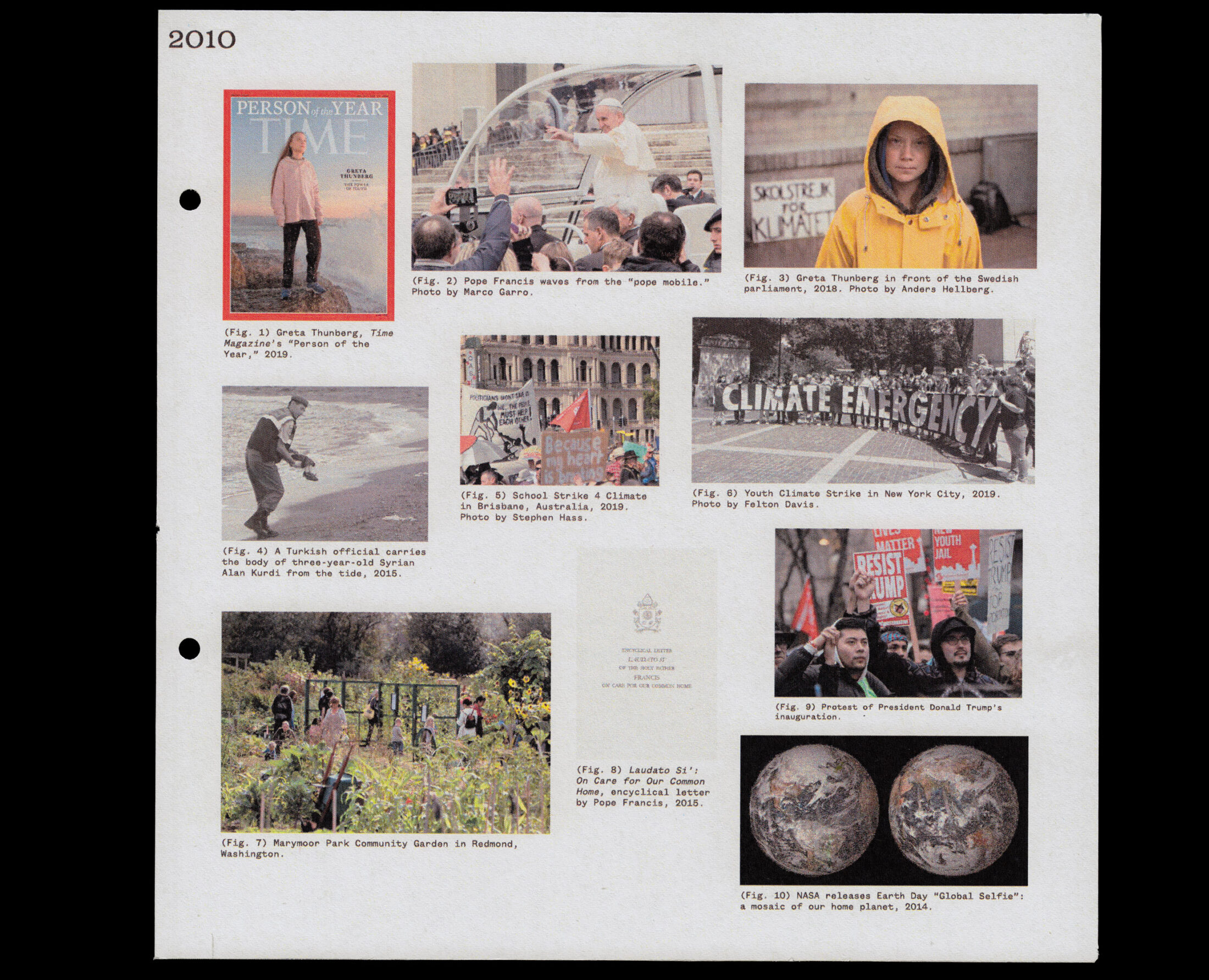

In mid-March—after the National Basketball Association suspended what was left of the 2019/2020 season, after colleges and universities sent students home for spring break or urged them firmly not to return, after Italy went into nationwide lockdown, and California followed—after all this, earthday.org declared that Earth Day 2020, the historic fiftieth anniversary, would take place online and indoors. Of course, the declaration ran counter to the great unexamined assumption of Earth Days from 1970 onward: namely, that any action undertaken outdoors to engage people directly with the natural world—the Earth—would lead the participants to care more than otherwise for the Earth and thus to take an active interest in its future. It seemed to stand Earth Day on its head in order to save the day itself.
Earthday.org has since taken steps akin to those taken by other organizations sidelined by the COVID-19 pandemic: setting up an Earth Day app for participants to use in monitoring trash and disregard for the planet; postponing its global cleanup day to September; putting out an appeal for online donations. In these same weeks, plenty of evidence has accrued that the withdrawal of whole populations from public life called forth by the coronavirus is just what the planet needed: large-scale, organized, mandated human inaction. Staying in, staying put, keeping one’s car parked in a space, keeping clear of the airport: these actions together have had sudden and striking effects on the planet and the atmosphere. Air quality has improved sharply in cities from New York to Mumbai. Aquatic life is visible again in Venice. Light pollution has declined, as has the consumption of fossil fuels in the form of gasoline and diesel. Long-sought urban initiatives such as congestion pricing to limit the use of carbon-producing vehicles in crowded cities suddenly seem insufficiently ambitious. What the planet and atmosphere needs, all this evidence suggests, is less human movement, activity, locomotion and enterprise; and if the indoor activities put in their place—the use of smartphones, computers, TVs, refrigerators, stoves, dishwashers, and the like—require carbon-powered electricity, so be it: in the short term, it’s clearly a trade-off worth making.
This development has obvious implications for the Earth Days of the future. It suggests that Earth Day actually might benefit from being stood on its head. In its second half century, this omnium-gatherum of collective action on behalf of the planet could become, instead, a moment of collective inaction. For a day, or a week, or a month, or a part of the year—say, from spring break to final exams, following Denis Hayes’s original scheme—people who wish to act on behalf of the planet could withdraw from carbon-emitting activity as fully as possible. We could cut back office hours, cook at home, leave our cars parked, and abstain from air travel; we could center our interactions around exercise, conversation, and simple human companionship. The press and the government could encourage such behavior by posting daily reports on air quality, fuel consumption, and the like. Just as we have watched the data of the pandemic—the epidemiological curves, the projections of peaks and flattenings—we could watch the data of the planet and atmosphere. On the one hand, this would show us, as sheltering-in has done, that there really is a correlation between collective action and its effects; on the other, it would remind us, as the coronavirus has done, that the toxic effects of our way of life are largely invisible: as present on a clear spring afternoon in New York as on a foggy winter morning in Beijing.
Returning to Sweden from a trip to central Europe, Thunberg self-quarantined, concluding that she had symptoms of COVID-19. A seasoned activist by that point, she took care not to draw overbold connections between health crisis and climate crisis. “The coronavirus is a terrible event … there is no positive to come out of it,” she said in an interview. “But it also shows one thing: That once we are in a crisis, we can act to do something quickly, act fast. Though it must be in a different way to how we have acted in this case, we can act fast and change our habits and treat a crisis like a crisis.”
For writers, the COVID-19 pandemic and the ensuing shutdown has produced a near-perfect set of circumstances for long-form journalism: a sudden, dramatic development, rich in human interest and in questions of cause-and-effect, at once exquisitely complicated and of great interest to a large public, who seek both understanding and recommendations for immediate action. It has produced, that is, the very set of circumstances that long-form journalists for fifty years have claimed existed around issues involving the Earth but without managing to persuade a large public to care and take action.
As spectacularly as Earth Day has developed over the past half century, inspiring awe and wonder for the Earth along the way, it hasn’t produced real change at the levels needed to address the problems the Earth and atmosphere face. If there is anything for us to learn from the pandemic, it’s that when we as a society take a crisis seriously, we are willing and able to change—to do things we didn’t think possible, to give up aspects of our way of life that we never thought we would give up for any reason. The planet is in crisis. The news of the crisis has been reported for half a century now. It’s time to treat the crisis as a crisis, and our response to COVID-19 suggests what a real response to a crisis might look like.

Ecological Conversion
Struck by the thought that the Catholic Church and the natural world have traded places as sources of transcendence, Paul Elie wonders how religion and the natural world might come together for shared renewal.
